Three-Axis Vector Magnetometer with a Three-Dimensional Flux Concentrator
Abstract
:1. Introduction
2. Design
3. Simulation
4. Sensor Manufacturing
5. Testing Setup
6. Measurement Results
6.1. Three-Axial Magnetic Field Sensing
6.2. Directional Magnetic Field Sensing
6.3. Noise Analysis
6.4. Demonstration
7. Conclusions
Author Contributions
Funding
Institutional Review Board Statement
Informed Consent Statement
Data Availability Statement
Acknowledgments
Conflicts of Interest
References
- Lenz, J.E. A review of magnetic sensors. Proc. IEEE 1990, 78, 973–989. [Google Scholar] [CrossRef]
- Vopálenský, M.; Ripka, P.; Platil, A.N. Precise magnetic sensors. Sens. Actuators A Phys. 2003, 106, 38–42. [Google Scholar] [CrossRef]
- Randjelovic, Z.B.; Kayal, M.; Popovic, R.; Blanchard, H. Highly sensitive Hall magnetic sensor microsystem in CMOS technology. IEEE J. Solid-State Circuits 2002, 37, 151–159. [Google Scholar] [CrossRef]
- Paun, M.A.; Sallese, J.-M.; Kayal, M. Hall Effect Sensors Design, Integration and Behavior Analysis. J. Sens. Actuator Netw. 2013, 2, 85–97. [Google Scholar] [CrossRef]
- Jogschies, L.; Klaas, D.; Kruppe, R.; Rittinger, J.; Taptimthong, P.; Wienecke, A.; Rissing, L.; Wurz, M. Recent developments of magnetoresistive sensors for industrial applications. Sensors 2015, 15, 28665–28689. [Google Scholar] [CrossRef] [PubMed]
- Primdahl, F. The fluxgate magnetometer. J. Phys. E 1979, 12, 241–253. [Google Scholar] [CrossRef]
- Guo, L.; Yang, Z.; Zhi, S.; Feng, Z.; Lei, C.; Zhou, Y. A sensitive and innovative detection method for rapid C-reactive proteins analysis based on a micro-fluxgate sensor system. PLoS ONE 2018, 13, e0194631. [Google Scholar] [CrossRef] [PubMed]
- Baschirotto, A.; Dallago, E.; Malcovati, P.; Marchesi, M.; Venchi, G. A Fluxgate magnetic sensor: From PCB to micro-integrated technology. IEEE Trans. Instrum. Meas. 2007, 56, 25–31. [Google Scholar] [CrossRef]
- Rovati, L.; Cattini, S. Zero-field readout electronics for planar fluxgate sensors without compensation coil. IEEE Trans. Ind. Electron. 2012, 59, 571–578. [Google Scholar] [CrossRef]
- Hsieh, P.H.; Chen, S.J. Multilayered vectorial fluxgate magnetometer based on PCB technology and dispensing process. Meas. Sci. Technol. 2019, 30, 125101. [Google Scholar] [CrossRef]
- Brauer, P.; Risbo, T.; Merayo, J.M.G.; Nielsen, O.V. Fluxgate sensor for the vector magnetometer onboard the ‘Astrid-2’ satellite. Sens. Actuators A Phys. 2000, 81, 184–188. [Google Scholar] [CrossRef]
- Petridis, C.; Dimitropoulos, P.D.; Hristoforou, E. New magnetic field sensor based on combined flux-gate/hall-effect arrangement. IEEE Sens. J. 2009, 9, 128–134. [Google Scholar] [CrossRef]
- Kubik, J.; Vcelak, J.; O’Donnell, T.; McCloskey, P. Triaxial fluxgate sensor with electroplated core. Sens. Actuators A Phys. 2009, 152, 139–145. [Google Scholar] [CrossRef]
- Da Silva, F.C.S.; Halloran, S.T.; Yuan, L.; Pappas, D.P. A z-component magnetoresistive sensor. Appl. Phys. Lett. 2008, 92, 142502. [Google Scholar] [CrossRef]
- Hsieh, P.H.; Chen, S.J. An out-of-plane sensing fluxgate magnetic field sensor with an assisted flux conductor. AIP Adv. 2021, 11, 015217. [Google Scholar] [CrossRef]
- Griffith, W.C.; Jimenez-Martinez, R.; Shah, V.; Knappe, S.; Kitching, J. Miniature atomic magnetometer integrated with flux concentrators. Appl. Phys. Lett. 2009, 94, 023502. [Google Scholar] [CrossRef]
- Leroy, P.; Coillot, C.; Mosser, V.; Roux, A.; Chanteur, G. An ac/dc magnetometer for space missions: Improvement of a Hall sensor by the magnetic flux concentration of the magnetic core of a search coil. Sens. Actuators A Phys. 2008, 142, 503–510. [Google Scholar] [CrossRef]
- Szewczyk, R.; Ostaszewska-Lizewska, A.; Råback, P. Modelling the Fluxgate Sensors with Magnetic Field Concentrators. Acta Phys. Pol. A 2020, 137, 700–702. [Google Scholar] [CrossRef]
- Zhao, J.; Tian, W.; Zhang, Q.; Pan, M.; Hu, J.; Chen, D.; Luo, F. Designs of slope magnetic flux guides for 3-axis magnetic sensor. IEEE Trans. Magn. 2013, 49, 5301–5303. [Google Scholar] [CrossRef]
- Lu, C.C.; Huang, J. A 3-axis miniature magnetic sensor based on a planar fluxgate magnetometer with an orthogonal fluxguide. Sensors 2015, 15, 14727–14744. [Google Scholar] [CrossRef] [PubMed]
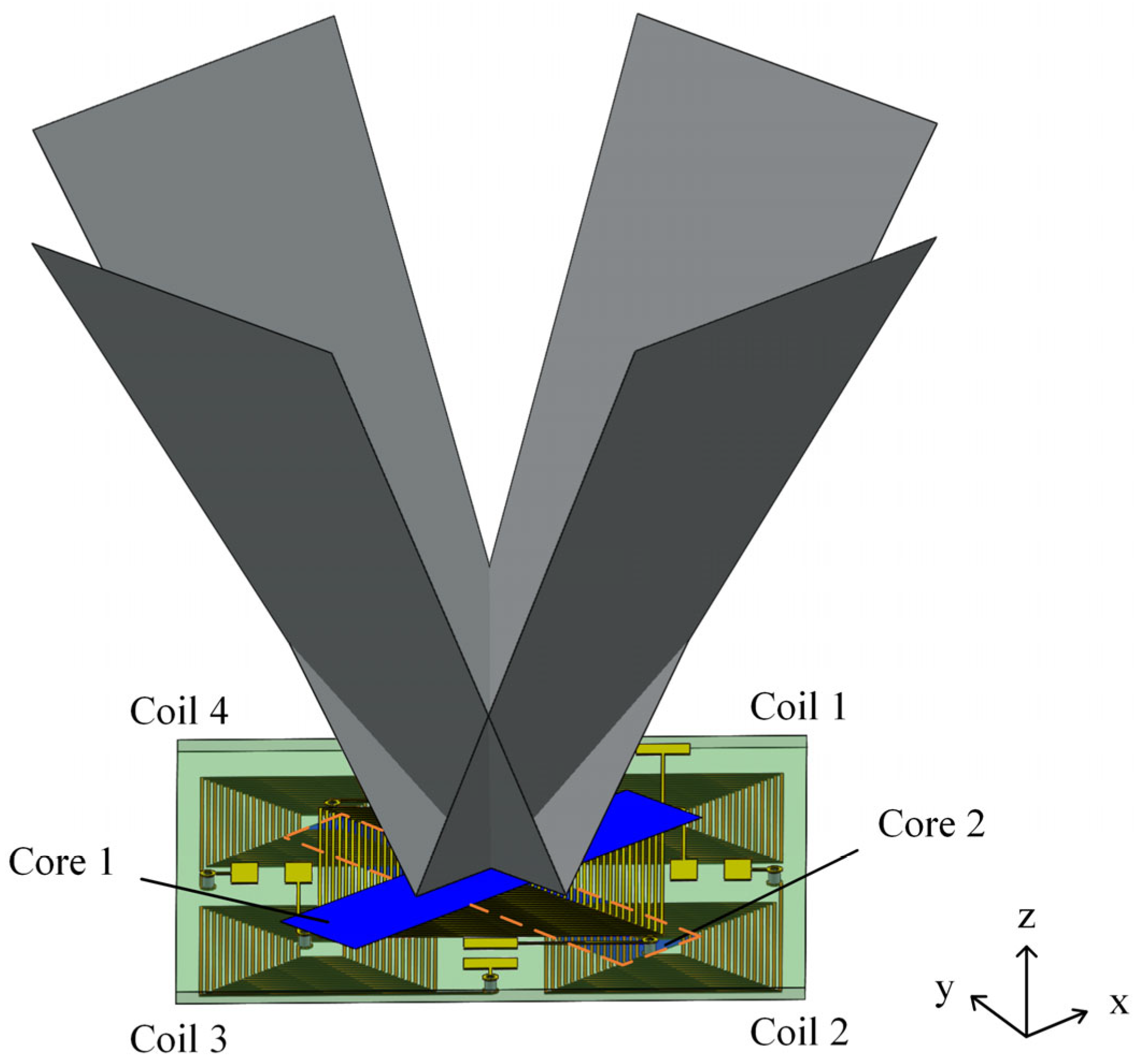


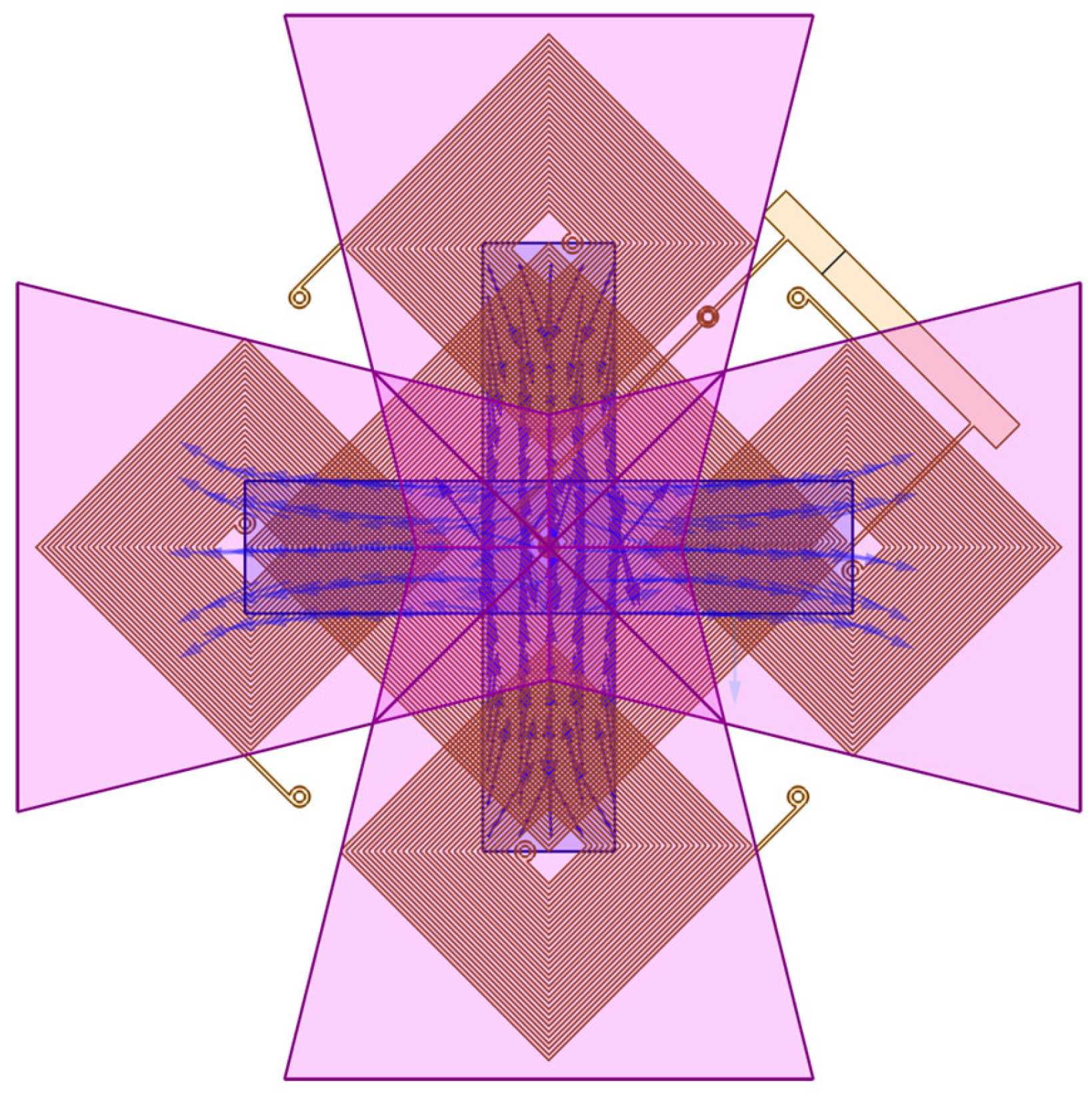
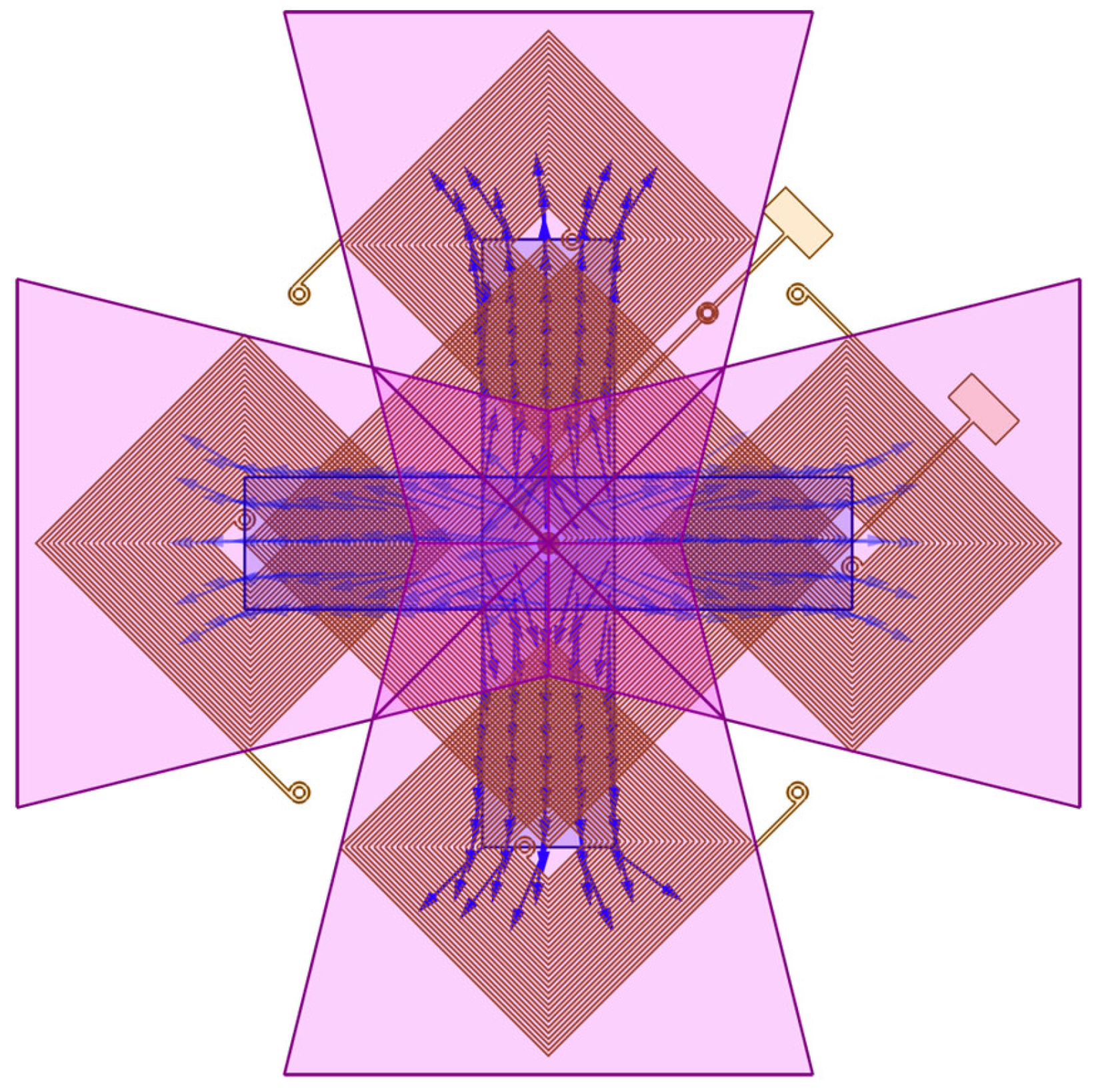
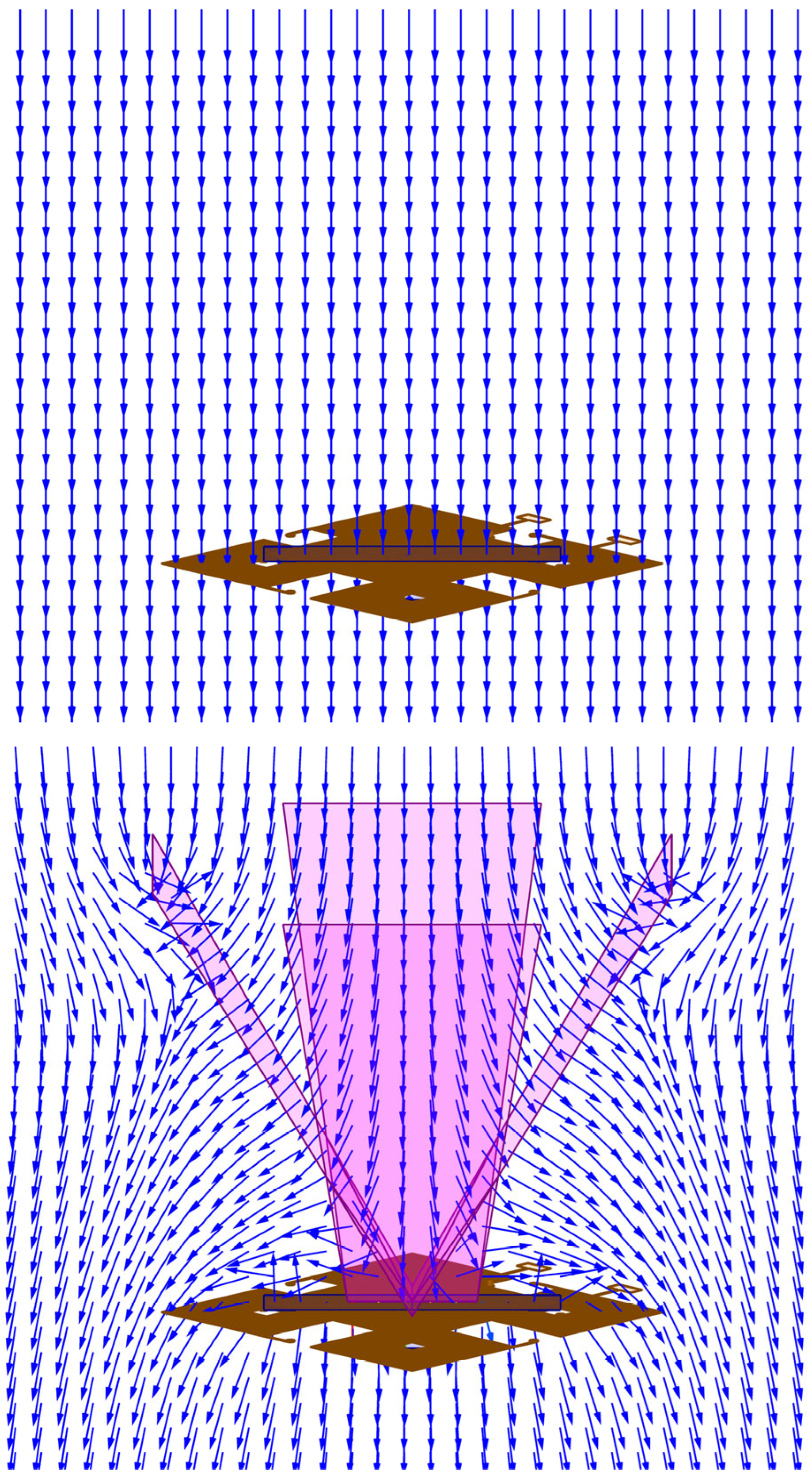
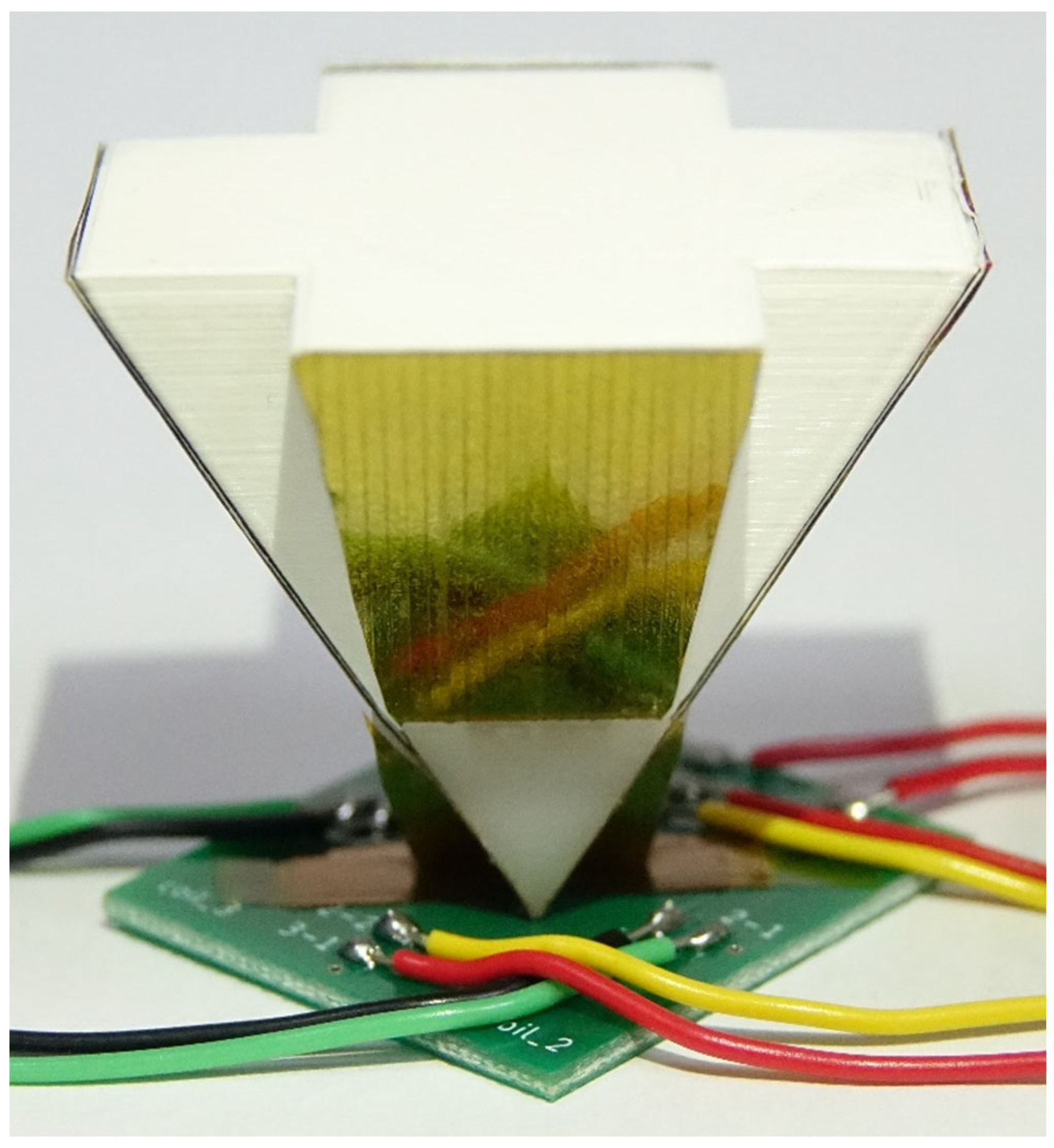

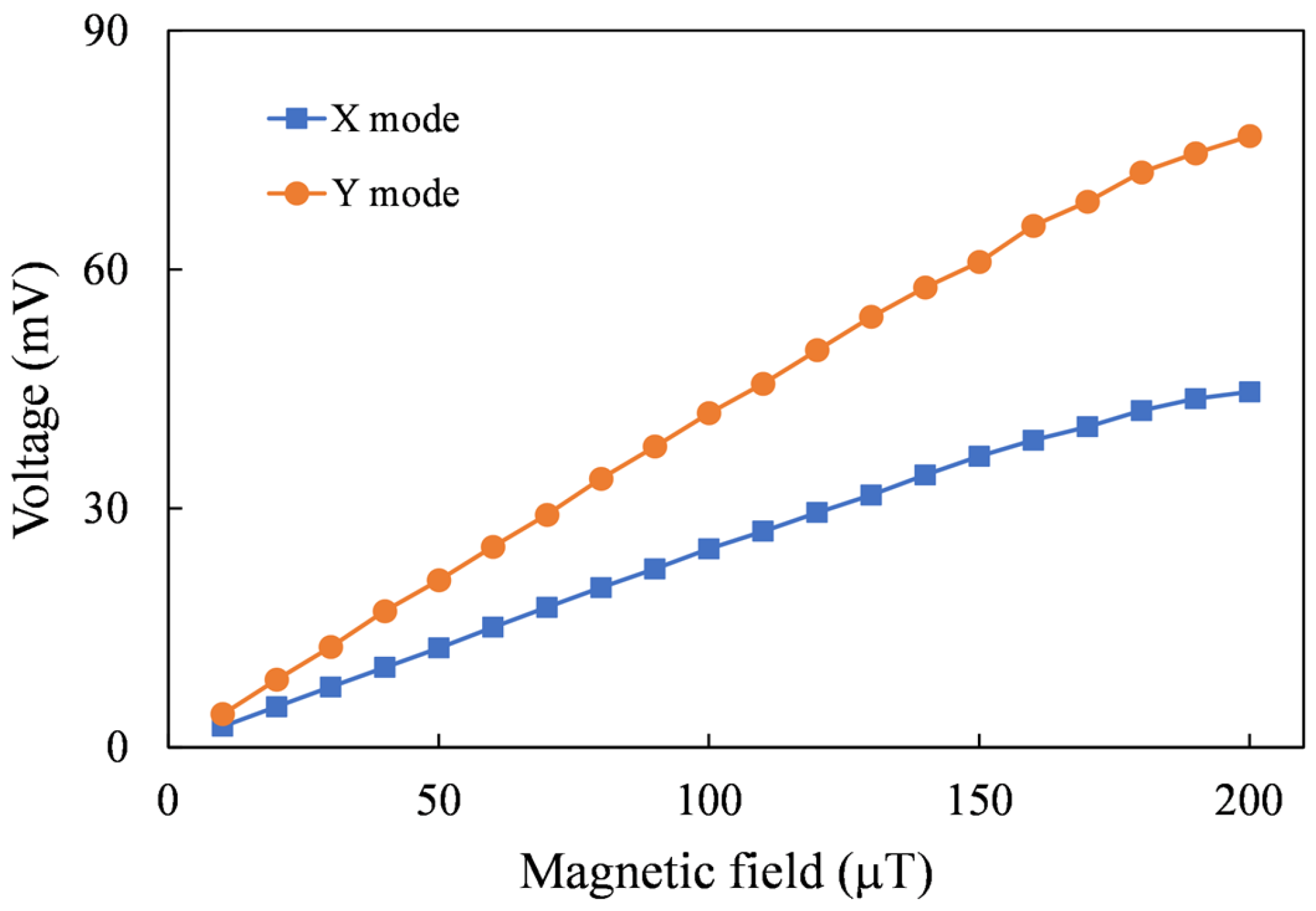


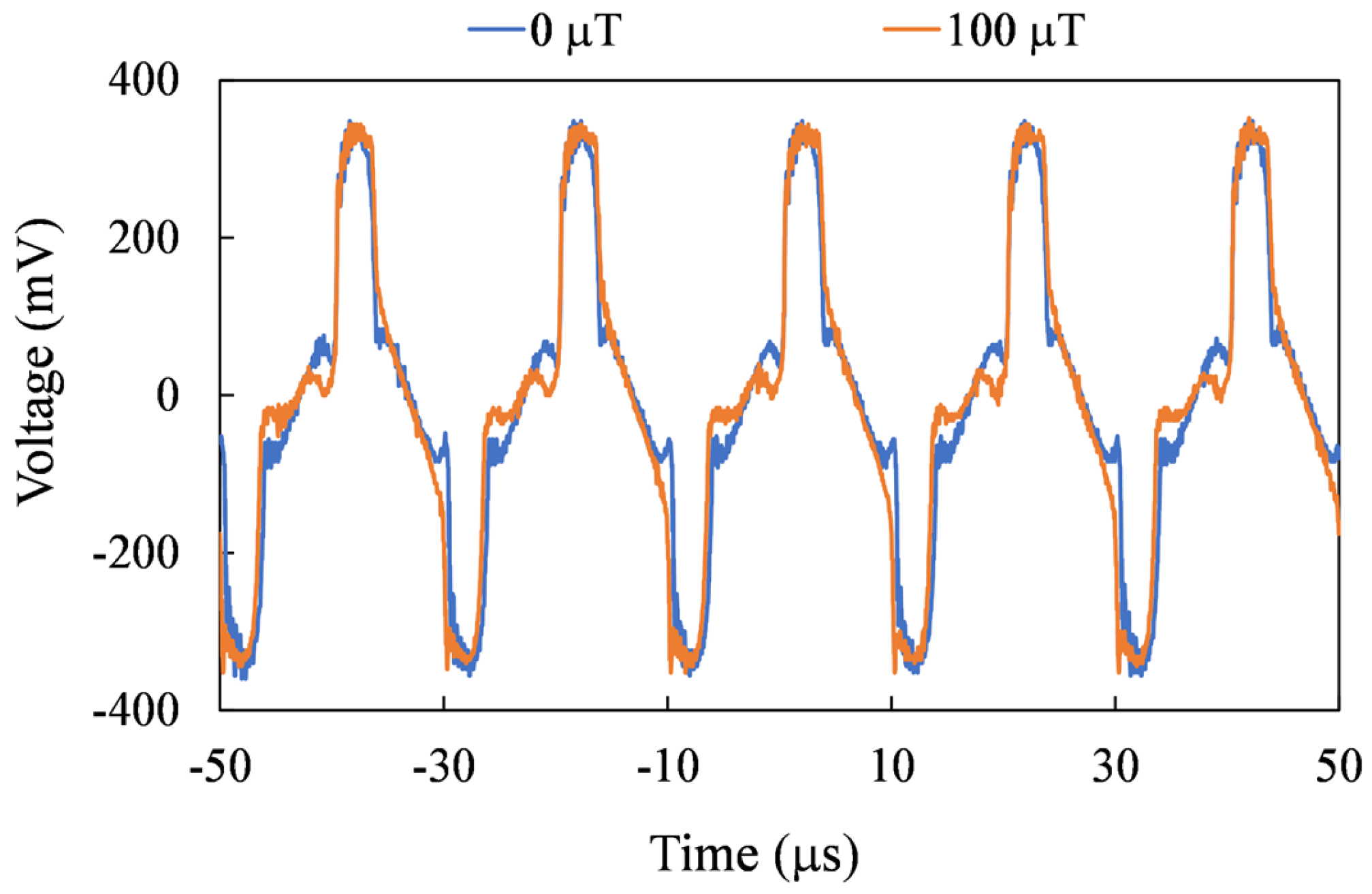
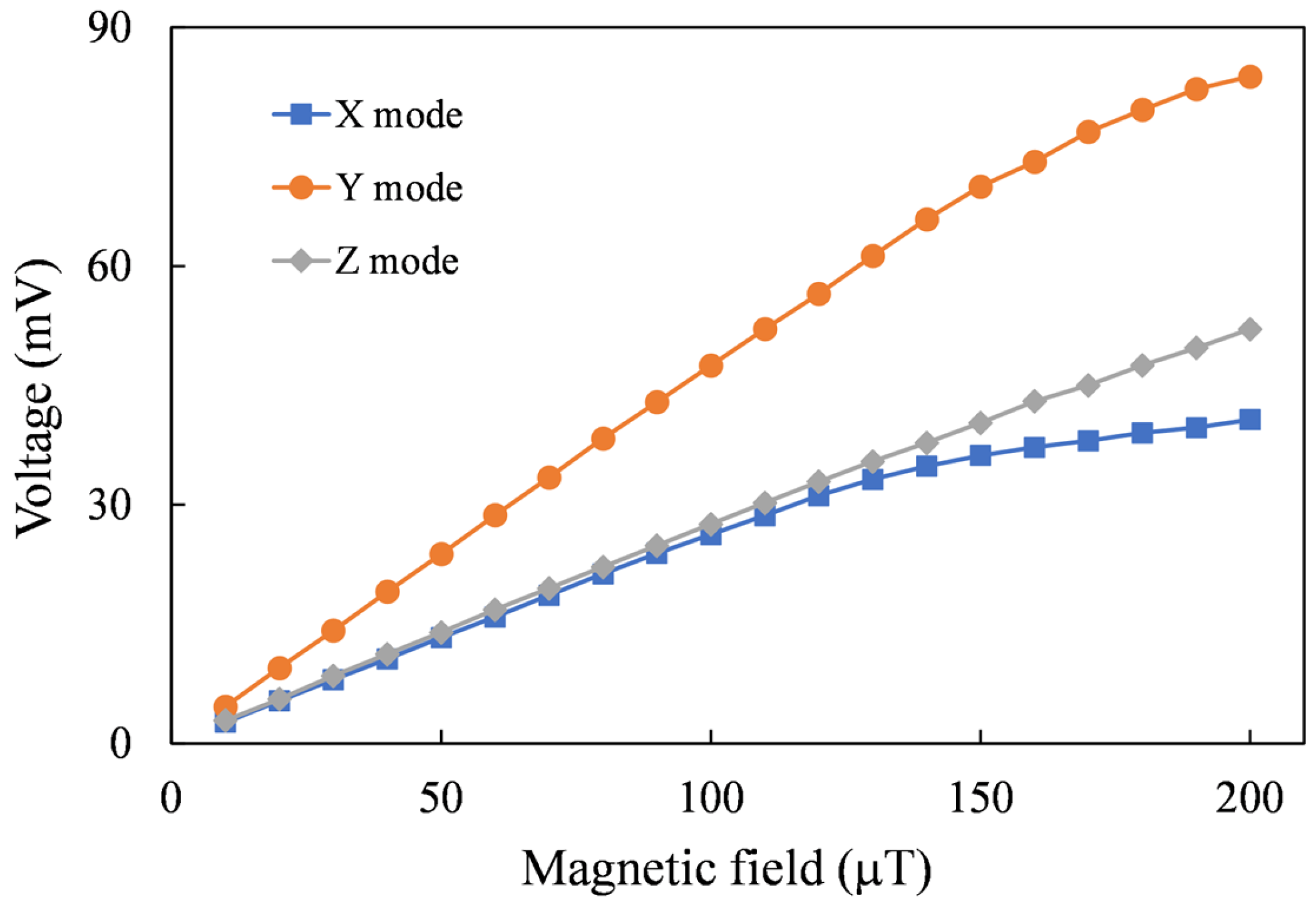
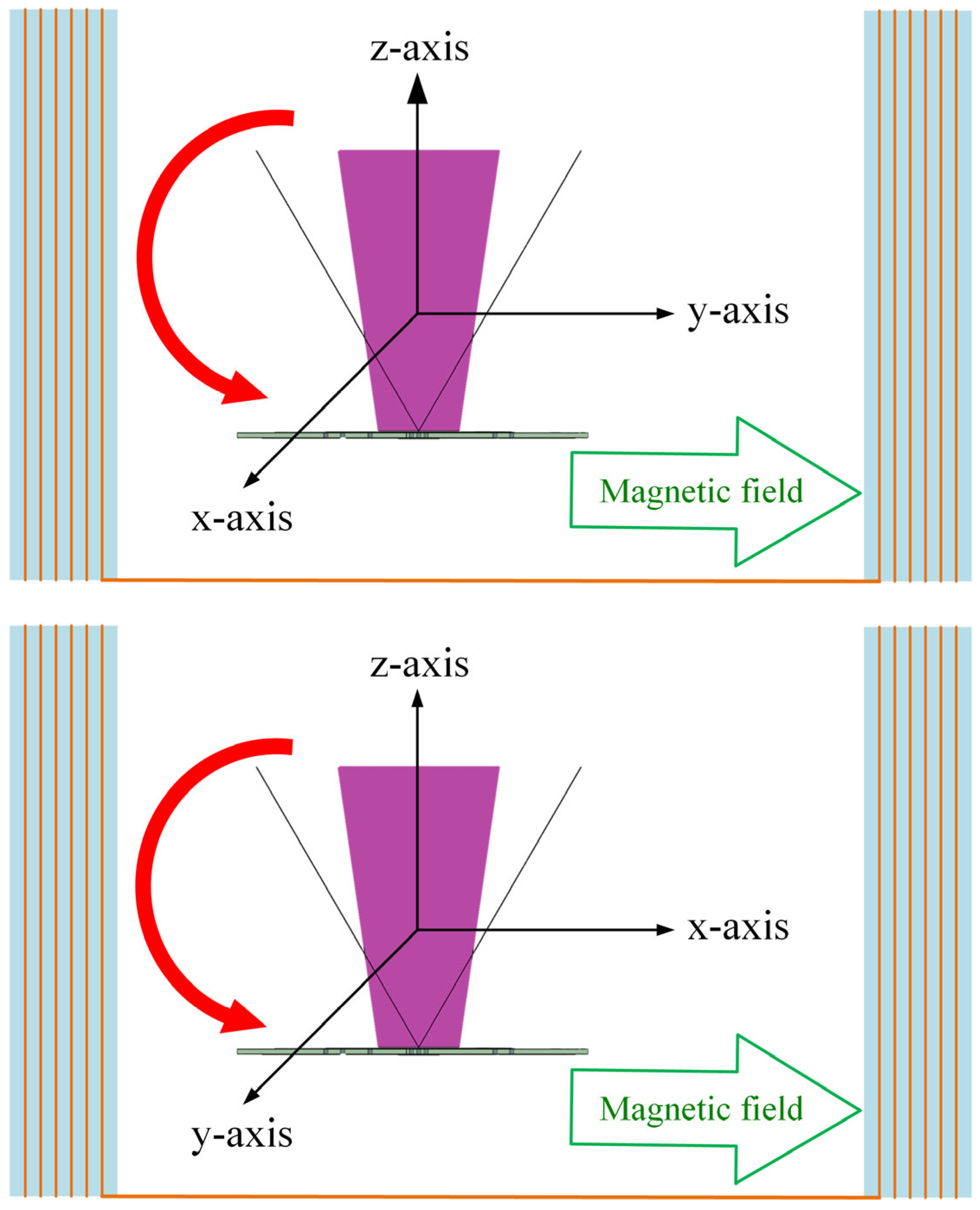
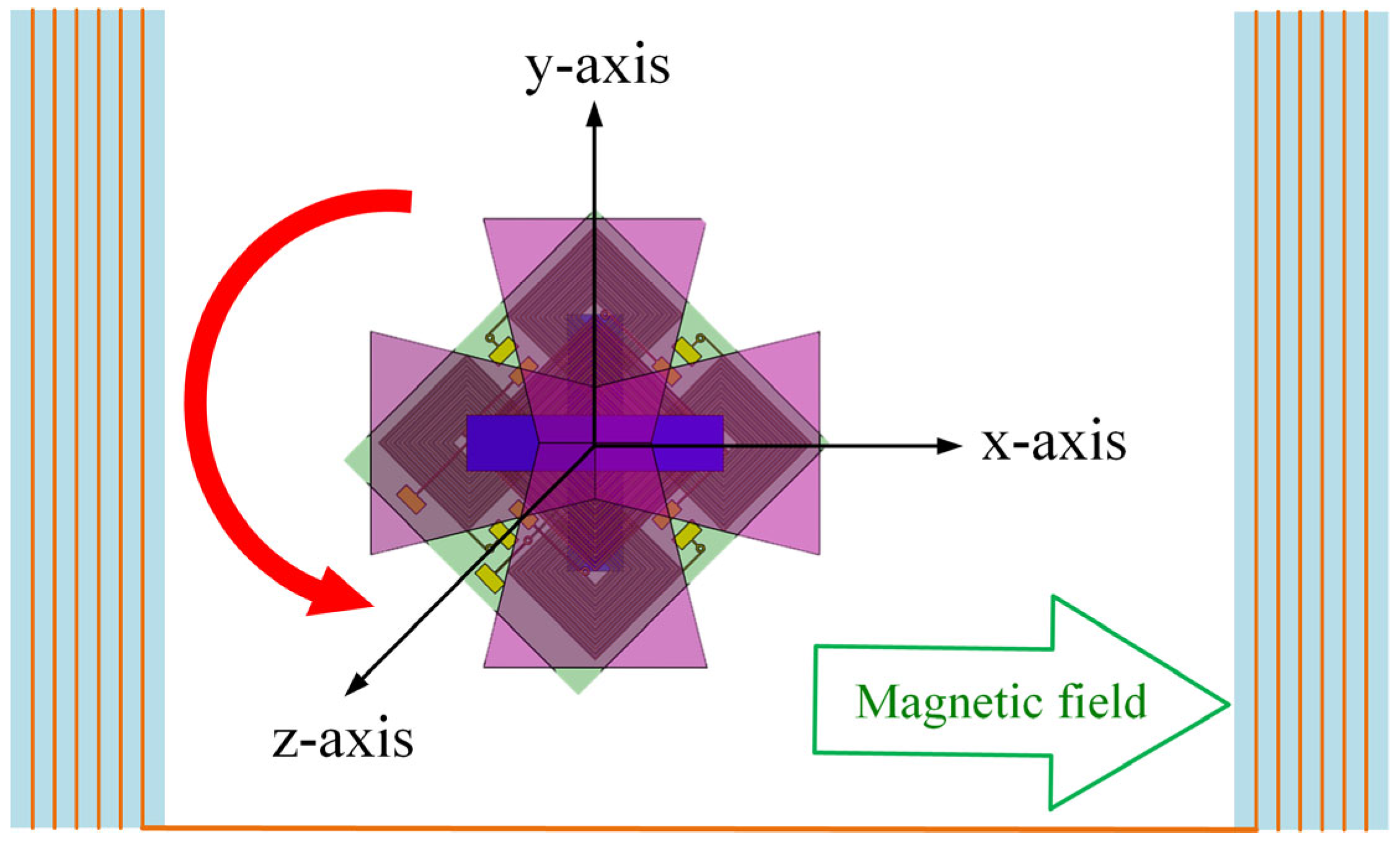
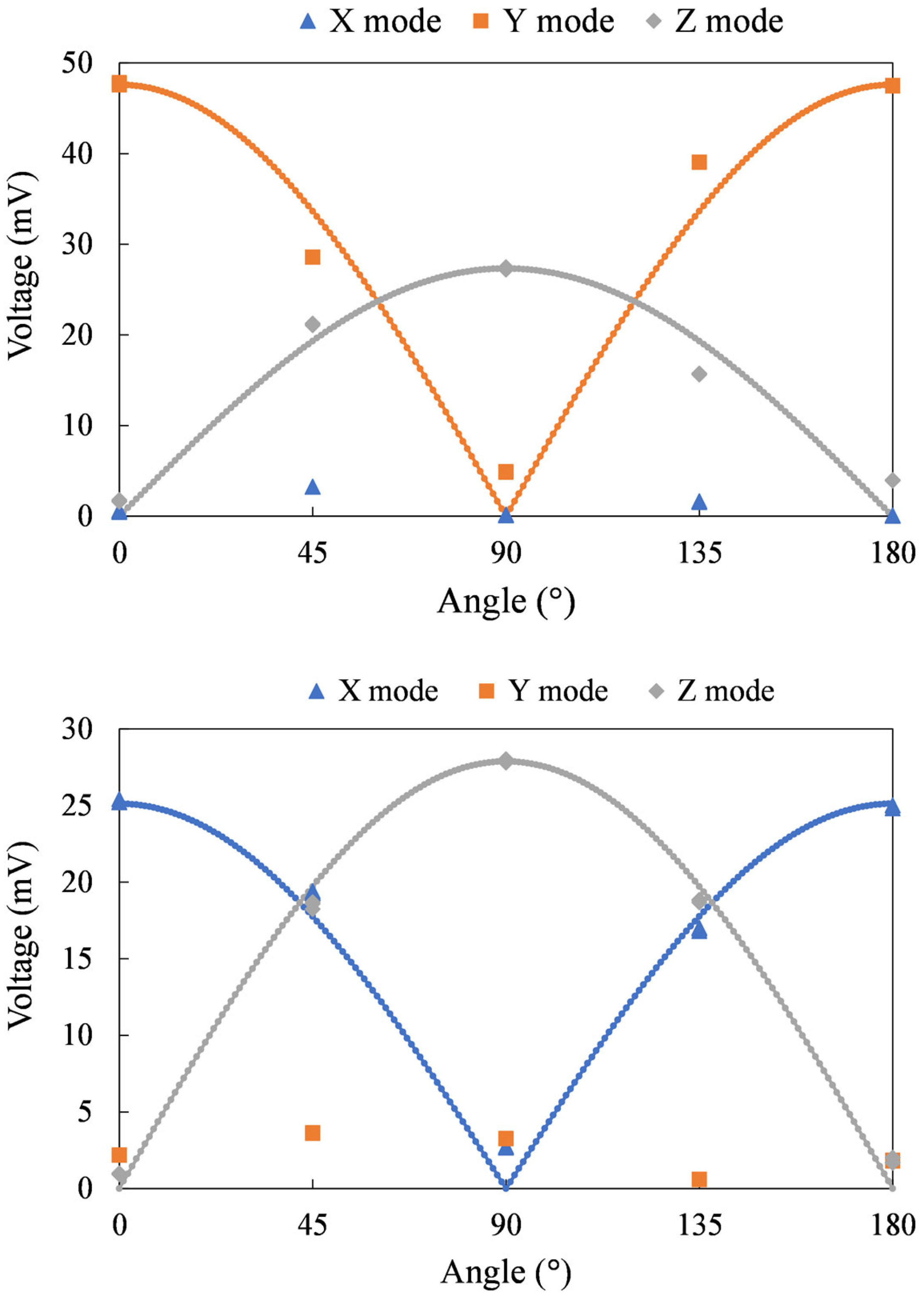
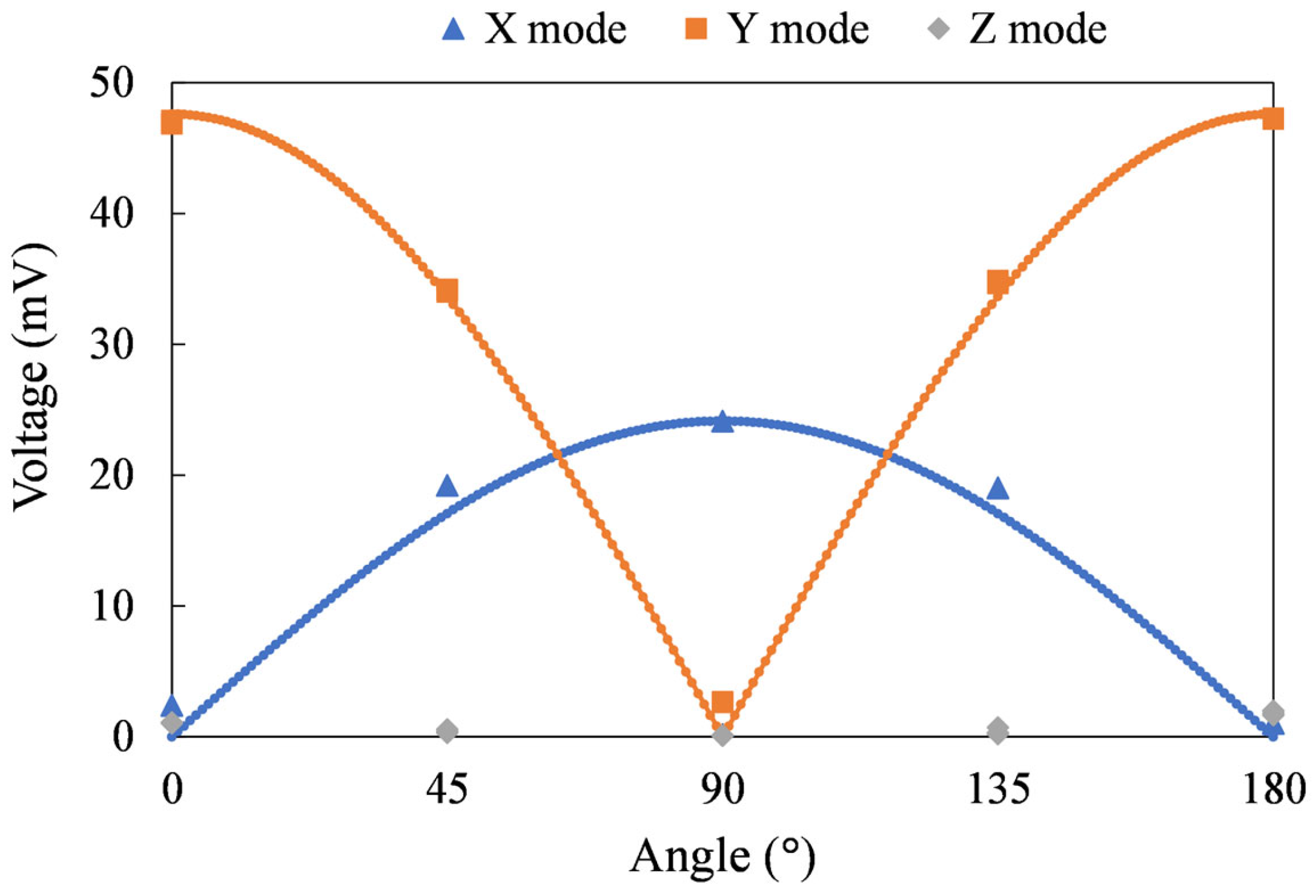




| Mode | Coil Pairs |
|---|---|
| X-axis | 1–3 |
| Y-axis | 2–4 |
| Z-axis | 1–2 and 3–4 |
| Parameters | Values |
|---|---|
| Excitation coil turns | 25 × 1 |
| Induction coil turns | 15 × 4 |
| Size | 29.8 × 31.9 mm2 |
| Hight of the flux concentrator | 34.9 mm |
| Angle of the flux concentrator | 60 |
| Mode | Sensitivity [V/T] | Linear Range [μT] |
|---|---|---|
| X-axis | 257.1 | 130 |
| Y-axis | 468.8 | 150 |
| Z-axis | 258.8 | 140 |
Disclaimer/Publisher’s Note: The statements, opinions and data contained in all publications are solely those of the individual author(s) and contributor(s) and not of MDPI and/or the editor(s). MDPI and/or the editor(s) disclaim responsibility for any injury to people or property resulting from any ideas, methods, instructions or products referred to in the content. |
© 2024 by the authors. Licensee MDPI, Basel, Switzerland. This article is an open access article distributed under the terms and conditions of the Creative Commons Attribution (CC BY) license (https://creativecommons.org/licenses/by/4.0/).
Share and Cite
Chen, S.-J.; Hong, D.-T.; Hsieh, P.-H.; Wang, T.-K. Three-Axis Vector Magnetometer with a Three-Dimensional Flux Concentrator. Sensors 2024, 24, 1659. https://doi.org/10.3390/s24051659
Chen S-J, Hong D-T, Hsieh P-H, Wang T-K. Three-Axis Vector Magnetometer with a Three-Dimensional Flux Concentrator. Sensors. 2024; 24(5):1659. https://doi.org/10.3390/s24051659
Chicago/Turabian StyleChen, Shih-Jui, Der-Tai Hong, Ping-Hsun Hsieh, and Tse-Kang Wang. 2024. "Three-Axis Vector Magnetometer with a Three-Dimensional Flux Concentrator" Sensors 24, no. 5: 1659. https://doi.org/10.3390/s24051659




